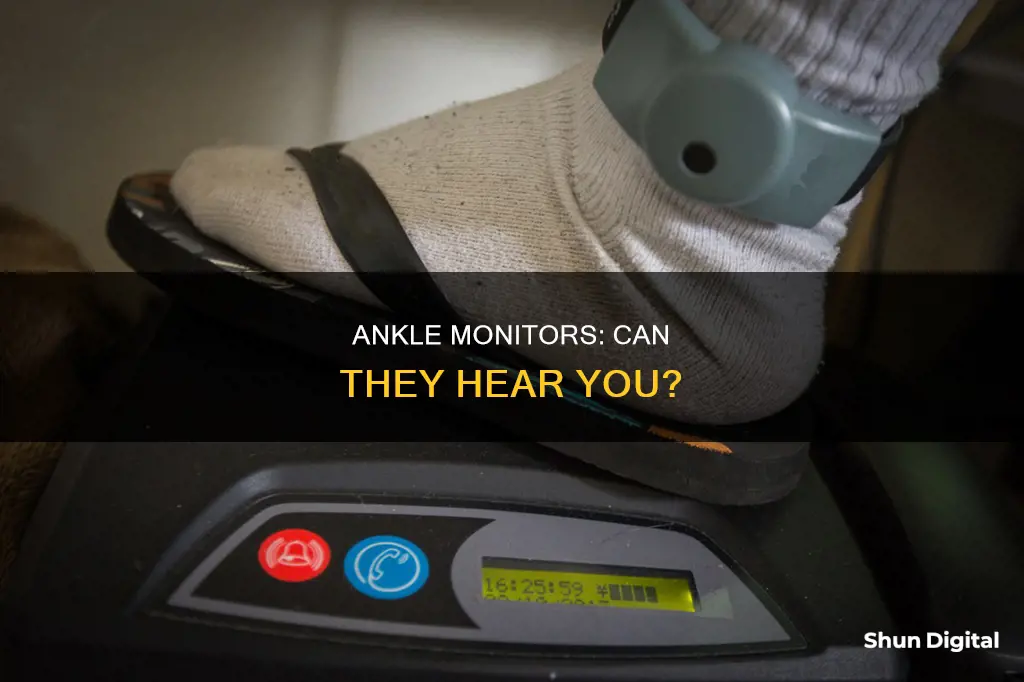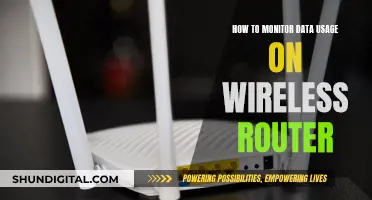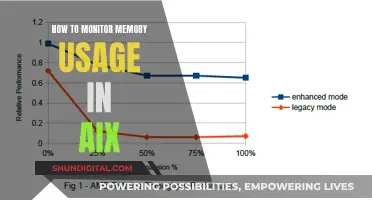
Ankle monitors are a form of electronic surveillance used to track an individual's location, usually as an alternative to incarceration. While they are designed to transmit location data via GPS or radio frequency, the addition of microphones and speakers has sparked privacy concerns. Some ankle monitors, such as the ReliAlert XC3, have been found to be capable of two-way communication and recording without the wearer's consent, raising questions about the extent of surveillance and the potential invasion of privacy. This has led to discussions on the balance between public safety, rehabilitation, and the individual's right to privacy and dignity.
| Characteristics | Values |
|---|---|
| Purpose | To allow the person to continue with their regular life while they await further court direction |
| Data Collection | Collects location data via GPS or radio frequency |
| Features | Waterproof, tamper-resistant, contains a GPS chip and a SIM card |
| Use Cases | House arrest, community control, immigration issues, alcohol consumption monitoring, parole or probation conditions |
| Rules | Maintain work, abide by an agreed schedule, pay court fees, meet with parole or probation officers, abstain from drugs and alcohol, do not tamper with the device |
| Criticisms | No secondary checks for data collected, incorrect data, battery issues, lack of emergency protocols, unclear data ownership |
| Microphone | Some ankle monitors have microphones, but not all. Privacy concerns have been raised about the use of microphones. |
What You'll Learn
- Ankle monitors can be used to track undocumented immigrants awaiting removal from the US
- They can also monitor alcohol consumption for repeat offenders of drink-driving
- Ankle monitors can be used to enforce house arrest
- They can be used to monitor individuals on parole or probation
- Ankle monitors can be used as an alternative to cash bail

Ankle monitors can be used to track undocumented immigrants awaiting removal from the US
Ankle monitors are used to track undocumented immigrants awaiting removal from the US. The US government has been using ankle monitors as an alternative to detention for immigrants, particularly those seeking asylum, while they await their court dates. This method of surveillance is intended to be more humane than keeping immigrants in detention centres.
The Intensive Supervision Appearance Program (ISAP) is a US government program that uses electronic ankle monitors, voice recognition, and tracking apps to surveil immigrants. The program is run by BI Incorporated, a subsidiary of the GEO Group, a private prison company. As of January 2024, there were at least 182,607 people enrolled in ISAP, making it the largest supervision program of any US law enforcement agency.
While proponents of the program argue that it is effective at increasing court appearance rates among immigrants, critics highlight the physical, mental, and emotional toll that ankle monitors can take on those who wear them. Immigrants in the ISAP program have reported various issues with the ankle monitors, including bruising, overheating, and electric shocks. In addition, the constant surveillance and arbitrary requirements of the program have been described as dehumanizing and traumatizing, leading to social isolation and difficulty finding and keeping employment.
The use of ankle monitors on undocumented immigrants has been controversial. Immigrant advocates and legal experts argue that the devices are inappropriate and inhumane for people seeking asylum. There are also concerns about the lack of regulation and transparency surrounding the data collected by these devices and the potential for privacy invasions.
Is Your Monitor Flicker-Free? Here's How to Tell
You may want to see also

They can also monitor alcohol consumption for repeat offenders of drink-driving
Ankle monitors are a form of surveillance that is often used as an alternative to prison or jail. They are most commonly used during probation or for pre-trial conditions that allow the defendant to be released with local restrictions or placed under house arrest.
Ankle monitors are also known as ankle bracelets or ankle tags and are worn by defendants who have been sentenced to house arrest or those who are on parole or probation. The monitors work by transmitting the location of the person wearing them via GPS, allowing law enforcement to track them and ensure they are in compliance with their court orders.
In addition to geolocation tracking, ankle monitors can also be used to monitor alcohol consumption for repeat offenders of drinking-related crimes, such as repeated DUIs. These devices can either measure blood alcohol content through the wearer's skin or provide remote breathalyser testing. Known as SCRAM (Secure Continuous Remote Alcohol Monitor) bracelets, they provide 24/7 transdermal alcohol testing by sampling the wearer's perspiration every 30 minutes. This automated testing eliminates the opportunity to drink around test schedules and helps to encourage long-term behaviour change and sobriety.
The use of ankle monitors for alcohol monitoring has been shown to be effective in reducing reoffending rates. Studies have found that wearing a SCRAM bracelet for at least 90 days, coupled with alcohol treatment, can reduce the risk of reoffending for those convicted of driving under the influence. This makes ankle monitors a valuable tool in helping to address alcohol-related issues and promote rehabilitation for repeat offenders.
While ankle monitors can provide benefits in terms of monitoring and rehabilitation, there are also concerns about the level of surveillance and intrusion into individuals' lives. Ankle monitors with two-way communication capabilities, for example, have been criticised for potentially infringing on privacy and dignity, as they can enable law enforcement to listen in on conversations at any time and anywhere.
Overall, while ankle monitors can provide valuable information and support for repeat offenders of drink-driving, it is important to carefully consider the potential benefits and drawbacks of using this technology to ensure that the monitoring is balanced with respect for the individual's privacy and dignity.
Is Your Monitor 3D? Check for These Clues
You may want to see also

Ankle monitors can be used to enforce house arrest
Ankle monitors are often used as an alternative to prison or jail time, with judges frequently ordering them for defendants who have been sentenced to house arrest, or those on parole or probation. They are also used for pre-trial conditions, allowing the defendant to be released with local restrictions or in-home confinement.
The use of ankle monitors has increased in recent years, in part due to prison overcrowding and the high cost of keeping defendants in jail. In the US, the number of people required to wear ankle bracelets increased by 140% between 2005 and 2015, and more than 100,000 people in the criminal justice system are under some form of electronic monitoring.
Ankle monitors are a form of surveillance, allowing law enforcement to track an individual's location via GPS or radio frequency. This enables authorities to ensure compliance with court orders, such as house arrest or restraining orders. If a person attempts to remove the bracelet, an alarm is triggered and police are dispatched to their last known location.
In addition to geolocation tracking, some ankle monitors have additional features such as alcohol consumption monitoring for repeat offenders of drink-driving crimes. They can measure blood alcohol content through the skin or provide remote breathalyser testing.
There has been some criticism of the use of ankle monitors, including concerns about privacy and the impact on the wearer's ability to reintegrate into society. Some also argue that they do not address the systemic issues that lead to incarceration, such as unemployment, poverty, and structural racism. There are also technical limitations, such as battery life and signal interference, which can lead to false violations.
Despite these concerns, ankle monitors can be an effective tool for monitoring individuals who pose a high risk of reoffending or committing violent crimes. They provide an alternative to incarceration, allowing individuals to remain in their community while being tracked and supervised by law enforcement.
Monitor Response Time: Testing in Milliseconds
You may want to see also

They can be used to monitor individuals on parole or probation
Ankle monitors are often used as an alternative to imprisonment, allowing individuals to serve their sentences while remaining in the community. They are typically used for people on probation or parole, or those awaiting trial. Ankle monitors are also used for individuals convicted of a crime but considered low-risk and not a danger to the community.
Ankle monitors are a form of surveillance, allowing law enforcement to track an individual's location via GPS. This ensures they are in compliance with their court orders, such as house arrest or in-home confinement. If a person attempts to remove the ankle monitor, an alarm will be triggered and police will be dispatched.
In addition to GPS tracking, ankle monitors can also be used to monitor alcohol consumption for repeat offenders of drinking-related crimes. These devices can measure blood alcohol content through the skin or provide remote breathalyser testing. This type of ankle monitor is known as a Secure Continuous Remote Alcohol Monitoring (SCRAM) bracelet and is often used as part of probation after a DUI arrest or conviction.
Ankle monitors provide several advantages over traditional imprisonment. They are less expensive than keeping an individual in jail and allow people to maintain their jobs and support their families. This can aid in their reintegration into society after completing their sentences.
However, ankle monitors also come with some disadvantages. They can be uncomfortable to wear and cause skin irritation. Individuals with ankle monitors are subject to strict rules and regulations, and any violation can result in additional penalties or imprisonment.
While ankle monitors do not currently have microphones, the advancement of technology has raised concerns about the amount of information they should be allowed to collect. There are privacy concerns surrounding the potential use of microphones in ankle monitors, as it would allow authorities to listen in on conversations and potentially invade the privacy of third parties who are not under surveillance.
Removing Matte Coating: Monitor Restoration Guide
You may want to see also

Ankle monitors can be used as an alternative to cash bail
Ankle monitors are increasingly being used as an alternative to cash bail, allowing individuals to remain free while awaiting trial. This is particularly common in cases where individuals are deemed a low-risk offender, or where there is pressure to reduce the number of people in pretrial detention.
Ankle monitors are a form of surveillance, allowing law enforcement to track an individual's location via GPS. This ensures that the individual complies with court orders, such as sticking to a specific area, avoiding certain people, or adhering to a curfew. In the case of repeat offenders, ankle monitors can also be used to detect alcohol consumption.
While ankle monitors provide an alternative to incarceration, there are concerns about the cost of these devices, which can be a financial burden for defendants, particularly those who are indigent or unable to work due to their monitoring conditions. Additionally, there are privacy concerns associated with ankle monitors, particularly with the introduction of two-way communication devices that enable law enforcement to listen in on conversations.
The use of ankle monitors as an alternative to cash bail has been criticised by some, who argue that it represents a form of "e-carceration" and an unnecessary intrusion into individuals' lives. However, others argue that it is a preferable alternative to incarceration, providing individuals with the opportunity to continue with their lives and reintegrate into society.
Overall, while ankle monitors can be a useful tool in the criminal justice system, there are important considerations regarding cost, privacy, and the potential for undue interference in individuals' lives.
Finding the Center: Monitor Coordinates Simplified
You may want to see also
Frequently asked questions
Yes, some ankle monitors have listening devices. In 2019, it was reported that a new generation of ankle monitors has speakers and microphones, enabling two-way communication between the wearer and law enforcement. However, not all ankle monitors have listening devices, and there are concerns about the invasion of privacy that these devices may cause.
Ankle monitors are electronic devices fitted to an individual's ankle to track their location via GPS or radio frequency. They are often used as an alternative to incarceration, allowing individuals to continue with their lives while awaiting trial or as a condition of parole or probation.
There are several concerns regarding ankle monitors with listening devices. Firstly, privacy invasion, as these devices can potentially record conversations without the wearer's consent, raising legal and ethical issues. Secondly, the accuracy of data collected by ankle monitors has been questioned, with reports of incorrect data leading to longer prison sentences or false accusations. Lastly, there are no specific rules or regulations prohibiting the use of microphones in ankle monitors, which may lead to further privacy intrusions if not properly regulated.







